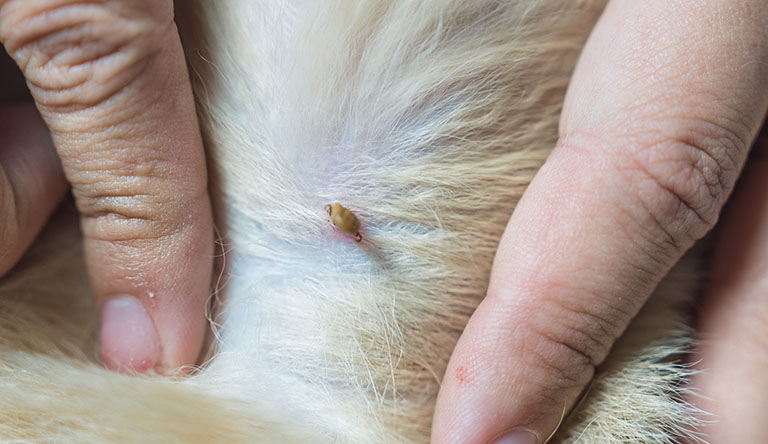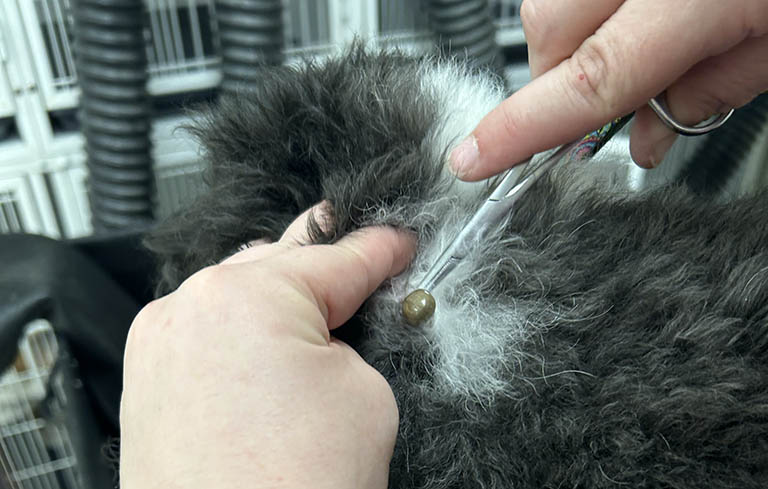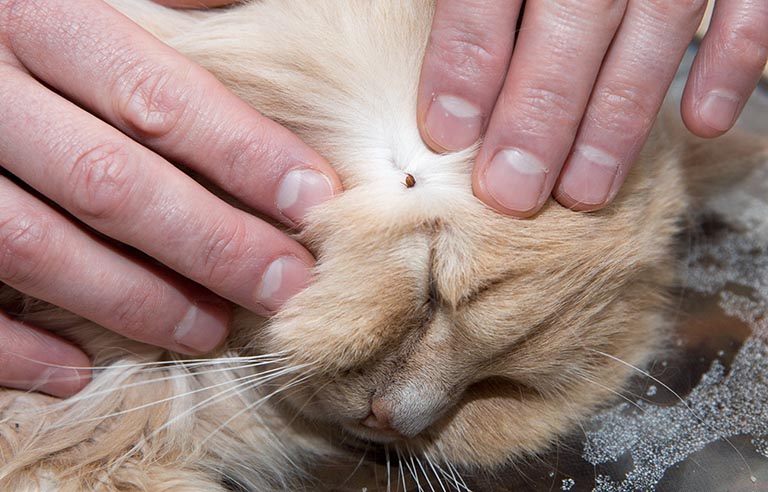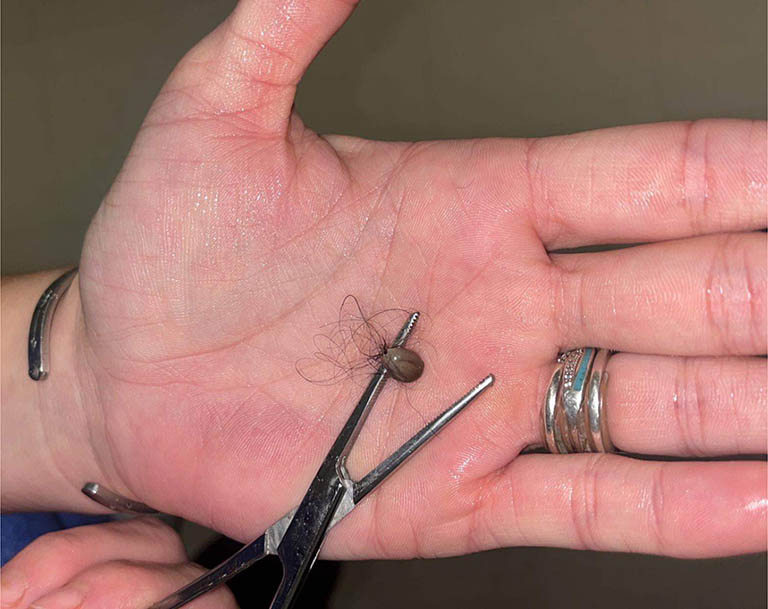Ticks are common pests that can affect both dogs and cats, especially those that spend time outdoors. According to the Centers for Disease Control and Prevention (CDC), ticks transmit several diseases to pets, with Lyme disease being one of the most common. It’s estimated that around 50% of dogs in certain areas are exposed to ticks annually. These tiny creatures can cause discomfort and spread diseases, so it’s important to know how to spot them, remove them safely and prevent them from attaching to your pets. This blog guides you through the signs of ticks on dogs and cats, how to remove them and the best prevention methods to keep your pets safe.

What Does an Embedded Tick on a Dog Look Like?
An embedded tick looks like a small, dark bump attached to your dog’s skin. Unlike a skin tag or other bump, a tick has legs visible near the attachment point. They can be gray, brown or black and will grow in size as they feed.
Ticks vs. Skin Tags on Dogs
Ticks and skin tags can look similar, but there are ways to tell them apart. Ticks are usually darker and have a hard shell. They may also move slightly if disturbed. Skin tags are the same color as your dog’s skin, won’t have legs, and are soft.

Pulling Ticks Out of Dogs
Removing ticks as soon as you find them is crucial to reducing health risks. If you feel comfortable doing it yourself, here’s what you need:
-
Tweezers or a tick removal tool, such as a tick twister
-
Disposable gloves to avoid contact with the tick
-
A dog-friendly disinfectant
Grasp the tick close to your dog’s skin with tweezers and pull it out in a steady, straight motion without twisting or crushing it. If you prefer, a tick twister tool can help safely remove the tick without leaving parts behind. After removal, disinfect the area to prevent infection. If you’re uncomfortable or your dog is distressed, visit a vet or a pet groomer to have the tick removed.

How to Check Your Dog for Ticks
Run your hands over your dog’s body, paying close attention to the head, neck, feet and ears. These areas are where ticks like to attach. Look for small, bump-like ticks that may not be obvious right away. Daily checks, especially after outdoor activities, help catch ticks early.
Ticks on Dogs Ears
Ticks often latch onto a dog’s ears, as the area is warm and has thin skin. Check around the ear flaps, inside the ear canal and behind the ears. This area may be harder to spot, so use a flashlight if needed for a thorough check.

How to Prevent Ticks on Dogs
Using a tick prevention plan is essential for protecting your dog. There are several options available, so choose what works best for your pet’s needs. Tick prevention should be year-round. While ticks are less active in colder months, the risk of infestation for your pet and home remains.
Dogs Ticks Tablet
Tick tablets, like Bravecto, provide protection against ticks and last up to three months. They are pork-flavored and are easy to give to your dog with a meal. These tablets are effective at killing ticks before they attach fully.
Oral Medication for Dogs for Ticks
Monthly oral medications like NexGard are also effective for preventing ticks. They work by killing ticks soon after they bite, reducing the risk of disease transmission. These are a great alternative to topical options.
Best Flea and Tick Collar for Dogs
The best flea and tick collars for dogs offer long-lasting protection and are easy to use. Seresto is a top choice, providing up to 8 months of protection against fleas and ticks. It’s water resistant, so it’s great for dogs that go outside often. Adams Flea and Tick Collar is another good option, lasting up to 7 months. Both collars are effective at killing and repelling pests. Choose the right size for your dog and follow the instructions for best results.
Spray Repellent for Ticks
Tick repellent sprays can be used on your dog before outdoor activities in areas with high tick populations. Look for pet-safe sprays specifically made to deter ticks. Avoid sprays with harsh chemicals that can irritate your dog’s skin.
Lawn Spray for Ticks
Keeping your lawn free from ticks is another way to protect your dog. Lawn sprays target ticks in grassy or wooded areas around your home. Apply according to the product’s directions, focusing on areas where your dog plays.
What Kills Ticks on Dogs Instantly? Home Remedies
Home remedies can sometimes be effective at killing ticks quickly. Use them as a temporary solution until you can reach a vet.
Ticks and Flea Shampoo for Dogs
A tick and flea shampoo helps wash away ticks and other pests from your dog’s coat. Use warm water and lather the shampoo thoroughly, paying close attention to common tick areas. Rinse well and follow the product’s instructions for best results.

How to Get Rid of Dog Ticks Naturally
Natural remedies can help get rid of dog ticks. Apple cider vinegar is a common option. Mix equal parts of vinegar and water in a spray bottle. Lightly spray your dog’s coat, focusing on areas like the neck, ears and paws. Essential oils like lavender or eucalyptus can also help repel ticks. But, always check with your vet before using essential oils. Some oils can be harmful to dogs, especially in large amounts.
Diatomaceous earth is another option. It can be sprinkled on your dog’s fur, but avoid the eyes and nose. It works by drying out ticks and other pests. Neem oil is also known to repel ticks and fleas. As with all remedies, check with your vet first to ensure they are safe for your dog.
These natural remedies can help, but they should be used with other tick prevention methods like regular checks, grooming and vet-recommended treatments.

Do Ticks Swim?
Ticks cannot swim, but they may survive in water for short periods. Water alone won’t kill them.
Can You Flush Ticks Down the Toilet?
It’s safe to flush ticks down the toilet, as they can’t crawl back out. Always dispose of ticks securely to prevent spreading diseases.
Ticks on Cats
Ticks can also attach to cats, so be sure to check them if they go outside.
Do Cats Get Ticks?
Yes, cats can get ticks, especially outdoor cats. Ticks are attracted to warmth and can attach to cats when they explore grassy or wooded areas. Outdoor cats are at higher risk because they are more likely to be in places where ticks live. It’s important to check your cat regularly for ticks, as they can be small and hard to find. Using tick prevention treatments like topical medicines or pills can help protect your cat from tick-borne diseases. Keeping your cat indoors or limiting outdoor time can also reduce the risk.

How to Remove Ticks from Cats
To safely remove a tick, use tweezers to grasp it close to its head, right where it attaches to the skin. Apply steady pressure and gently pull the tick straight out, being careful to remove it entirely. If any part remains attached, it’s best to visit your veterinarian for further extraction. Avoid squeezing the tick to prevent pushing any fluids or parts of its body back into the skin of the cat. Clean the area afterwards to help prevent infection.
Dogs and Ticks
Ticks can be a serious health risk for pets, but with regular checks and proper prevention methods, you can keep your dog and cat safe. Whether using medication, natural remedies or simply checking your pet after outdoor activities, taking action quickly is key. By staying vigilant and proactive, you can help protect your pets from the dangers ticks pose.


